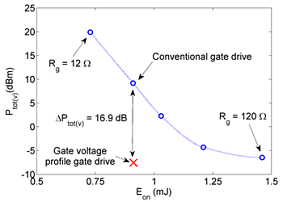 Active gate driving of IGBTs
Active gate driving of IGBTs
Silicon power electronic devices such as IGBTs and MOSFETs can also be controlled via the gate. Here less speed is required, e.g. 120 MHz arbitrary waveform generation is adequate. Therefore, it can be demonstrated using a fast benchtop arbitrary waveform generator and a high-speed buffer. The profiled gate signal (in purple) is initially ramped up quickly, in order to quickly reach the onset of switching. Then the ramp is slowed to soften the voltage waveform as it begins to fall, an important source of EMI. Following this, the current overshoot is tailored using a sequence that includes a negative ramp. The aim is to create an S-shaped voltage (red), and a reduced and widened current overshoot (blue).
 Reduced EMI and increased efficiency
Reduced EMI and increased efficiency
Active gate driving produces switching waveforms with less electromagnetic interference, and in addition, because the duration of the switching transient has not been lengthened, the switching power loss remains the same or can even be reduced. In this way, the traditional trade-off between switching noise and loss can be improved, as shown in the figure. The resulting converter is smaller, for the same power throughput.
References
N. F. Oswald, B. H. Stark, J. N. McNeill, “IGBT gate voltage profiling as a means of realising an improved trade-off between EMI generation and turn-on switching losses”, 6th IET International Conference on Power Electronics, Machines and Drives, PEMD, 2012.
PhD Opportunities
Interested in the electric revolution, future of transport or Power Electronics? We're looking for enthusiastic and motivated students to join the EEMG.
Fully funded PhD scholarships for Chinese students to carry out research at the University of Bristol
Contact
To trial our active gate driver ICs, please contact Bernard Stark.
We are keen to work with companies to develop drivers for specific applications, and to help other research groups and companies set up test benches using our ICs.